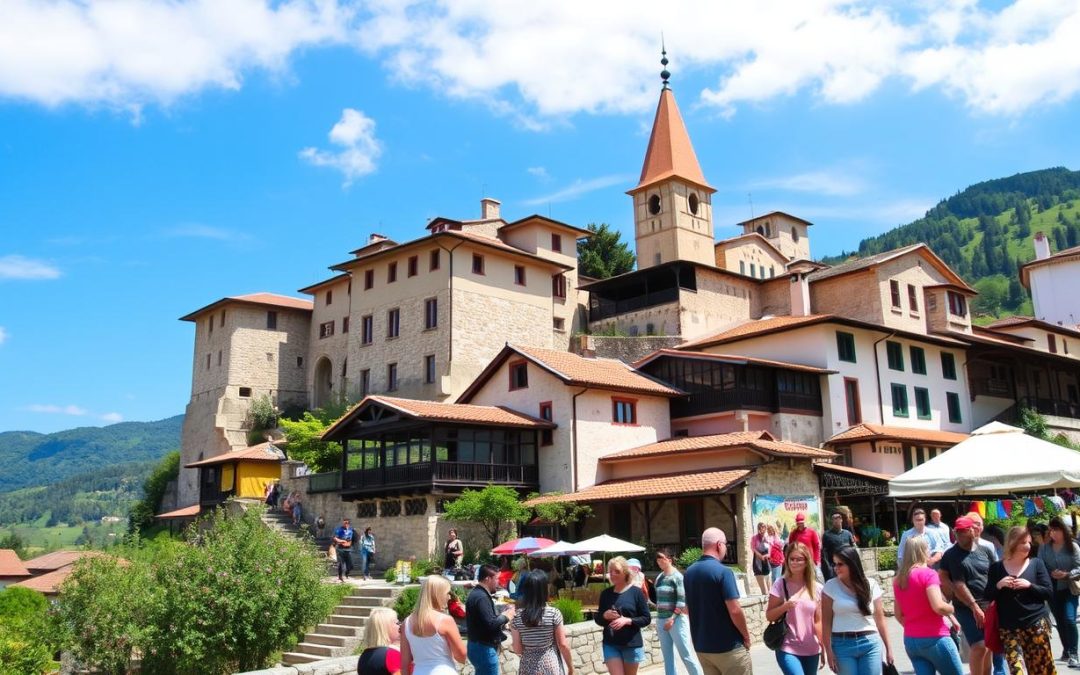Have you ever wondered how a small Balkan country manages to embrace three official languages while maintaining cultural harmony? Bosnia and Herzegovina stands as a fascinating linguistic crossroads that challenges traditional notions of national language identity.
In the heart of the Balkans, linguistic diversity is not just a characteristic but a fundamental aspect of national identity. Bosnia and Herzegovina uniquely represents a multilingual landscape where Bosnian, Serbian, and Croatian coexist as official languages. This reflects the country’s complex historical and cultural tapestry.
The linguistic diversity of Bosnia and Herzegovina tells a rich story of cultural interactions, historical transformations, and national resilience. With approximately 2.7 million native Bosnian speakers and a population that embraces multiple ethnic backgrounds, this country offers a remarkable example of linguistic complexity.
Key Takeaways
- Bosnia and Herzegovina has three official languages: Bosnian, Serbian, and Croatian
- Linguistic diversity reflects the country’s multicultural heritage
- Approximately 2.7 million people speak Bosnian natively
- Languages represent different ethnic groups: Bosniaks, Serbs, and Croats
- The country uses both Latin and Cyrillic alphabets
The Linguistic Landscape of Bosnia and Herzegovina
Bosnia and Herzegovina is in the heart of the Balkans. It’s a place of rich language diversity. This diversity comes from a long history of cultural and political changes.
Historical Language Development
The languages of Bosnia and Herzegovina have a long story. This story includes:
- Slavic migrations in the 6th and 7th centuries
- Ottoman Empire’s profound linguistic influence
- Austro-Hungarian administrative impacts
- Yugoslavia’s linguistic integration period
Language Distribution Dynamics
In Bosnia and Herzegovina, three main languages live together. The way these languages spread shows the country’s diverse people:
| Language | Percentage | Primary Regions |
|---|---|---|
| Bosnian | 45% | Central Bosnia |
| Serbian | 35% | Eastern Regions |
| Croatian | 20% | Western Herzegovina |
Cultural Language Interactions
In Bosnia and Herzegovina, languages do more than just talk. Linguistic diversity here is a story of cultural strength and understanding.
Language is the roadmap of a culture. It tells you where its people come from and where they are going.
From the Ottoman era to today’s digital world, Bosnia and Herzegovina keeps its language alive. It shows how language changes with history and culture.
Understanding the Three Official Languages
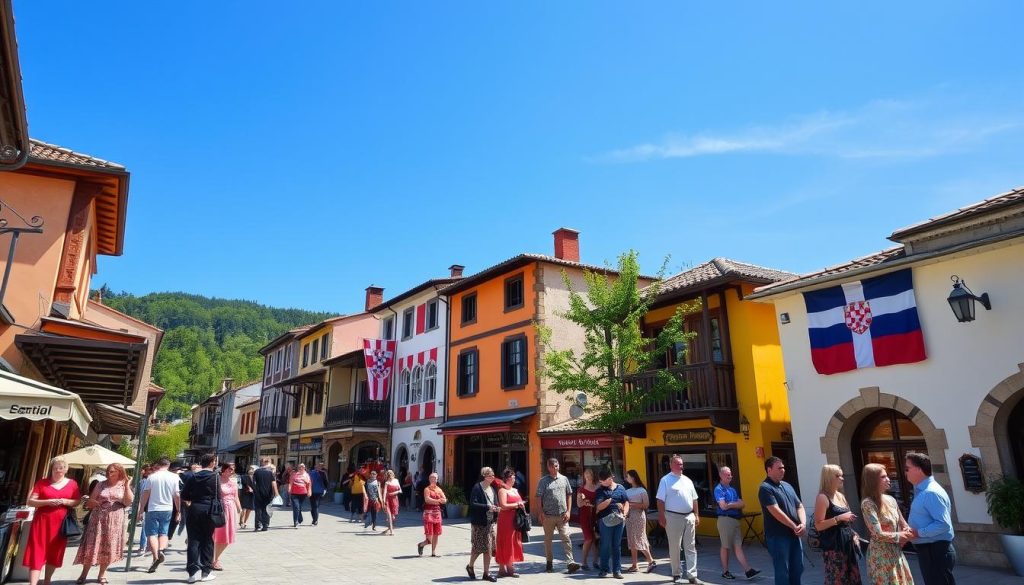
In Bosnia and Herzegovina, language is more than just talking. It shows who we are culturally. The country has three official languages: Bosnian, Serbian, and Croatian. Each one has its own special traits that tell a deep story of history.
These languages come from the Shtokavian dialect of Serbo-Croatian. They are so close that people can usually understand each other easily. Let’s look at what makes each language unique:
- Bosnian language: Uses the Latin script mostly
- Serbian language: Can be written in both Cyrillic and Latin alphabets
- Croatian language: Mainly uses the Latin script
Here are some interesting facts about language use in Bosnia and Herzegovina:
- Bosnian language speakers: About 2-3 million
- Serbian language speakers: More than 1 million
- Croatian language speakers: Over 400,000
“Language is the road map of a culture. It tells you where its people come from and where they are going.” – Rita Mae Brown
Even though these languages seem similar, they tell different stories. Bosnian has more Turkish and Arabic words. Serbian has Russian influences. Croatian is closer to Western European languages.
Knowing these differences helps us see the beauty of Bosnia and Herzegovina’s languages. Language is a key part of culture and history here.
The Bosnian Language: Features and Development
The Bosnian language is a rich mix of cultures, showing Bosnia and Herzegovina’s complex history. It’s a standardized language with deep roots and interesting traits.
Exploring the Bosnian language, you find a complex mix of cultures. It shows the region’s varied history.
Phonetic Characteristics
Bosnian phonetics have unique features:
- Complex vowel and consonant system
- Distinctive pronunciation patterns
- Rich sound variations reflecting cultural diversity
Grammatical Structure
The Bosnian language’s grammar is complex:
- Flexible noun declension system
- Intricate verb conjugations
- Sophisticated case system with seven distinct cases
Vocabulary and Loanwords
Bosnian vocabulary is a mix of many languages:
| Language Origin | Percentage of Loanwords |
|---|---|
| Arabic | 25% |
| Turkish | 20% |
| Persian | 15% |
| Slavic | 40% |
The Bosnian language uses both Latin and Cyrillic alphabets. This shows Bosnia and Herzegovina’s diverse ethnic makeup. Bosniaks make up about 48% of the population, making the language a key part of their identity.
“Language is the road map of a culture. It tells you where its people come from and where they are going.” – Rita Mae Brown
Learning about the Bosnian language helps us understand Bosnia’s rich culture. It shows how language diversity is a big part of their heritage.
Serbian Language in Bosnia and Herzegovina
The Serbian language is very important in Bosnia and Herzegovina. It is one of the three official languages and deeply rooted in the culture. About 1,086,027 people speak Serbian, making it a big part of the population’s identity.
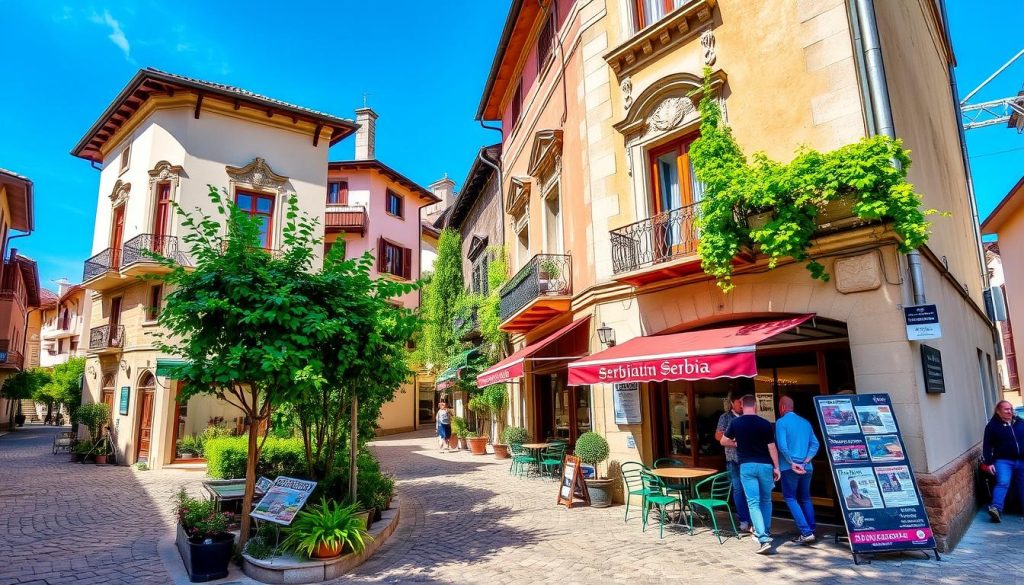
- Primarily written in Cyrillic script
- Closely related to other languages in the region
- Reflects the complex ethnic history of Bosnia and Herzegovina
The way Serbian is spoken in Bosnia and Herzegovina is different from Serbia. This difference comes from the country’s complex history and culture. Local dialects and regional influences make it unique.
“Language is the road map of a culture. It tells you where its people come from and where they are going.” – Rita Mae Brown
To understand Serbian, you must see its role in the country’s official languages. It is a key part of Serbian culture in Bosnia and Herzegovina.
| Serbian Language Statistics | Data |
|---|---|
| Total Speakers in Bosnia and Herzegovina | 1,086,027 |
| Primary Writing System | Cyrillic Script |
| Official Language Status | Yes |
The Serbian language in Bosnia and Herzegovina has faced many challenges. Its growth shows the history and culture of the region.
Croatian Language: Distinctive Features and Usage
The Croatian language is a key part of Bosnia and Herzegovina’s culture. It has unique features that make it stand out among Slavic languages. Learning about it is fascinating.
In Bosnia and Herzegovina, Croatian shows off its rich cultural heritage through language. It has about 5.5 million speakers worldwide. This makes it a vital part of the country’s language mix.
Alphabet and Writing System
Croatian uses the Latin alphabet, known as Gaj’s alphabet. This makes writing it easier. It has:
- Exclusively Latin script
- Unique diacritical marks
- Clear pronunciation rules
Regional Variations
Croatian has three main dialects, adding to its diversity:
- Čakavian
- Kajkavian
- Štokavian (most widely spoken)
“Language is the road map of a culture. It tells you where its people come from and where they are going.” – Rita Mae Brown
Modern Usage Patterns
In Bosnia and Herzegovina, Croatian is very flexible in modern use. It’s used in schools and in the media.
| Domain | Croatian Language Usage |
|---|---|
| Education | Primary instruction language |
| Media | Broadcast and print communication |
| Official Documentation | Co-official language status |
Learning Croatian gives you a peek into Bosnia and Herzegovina’s rich linguistic diversity. It shows a communication system deeply rooted in culture.
Writing Systems and Alphabets
Explore the world of writing systems in Bosnia and Herzegovina. This country is known for its rich linguistic heritage. It uses both Latin and Cyrillic alphabets in its communication.
The official languages of Bosnia and Herzegovina have unique writing traditions. The region has a complex cultural background, shown through its use of multiple scripts. Let’s look at the main writing systems:
- Latin Alphabet: Most commonly used in everyday communication
- Cyrillic Alphabet: Historically important, but less prevalent today
- Arabic Script: Used in historical and religious contexts
The development of the Bosnian language is fascinating. Cyrillic was widely used since the late 10th century. But, the Latin alphabet has become more popular over time.
| Alphabet | Current Usage | Historical Significance |
|---|---|---|
| Latin | Primary everyday use | Adopted during Yugoslav period |
| Cyrillic | Limited official use | Traditional script since 10th century |
| Arabic | Cultural and religious contexts | Historical literary and religious writing |
Interestingly, the Bosnian language demonstrates remarkable adaptability. Cyrillic was once common, but now Latin is used more. This change shows how language adapts in a multicultural society.
“Languages are the roadmaps of a culture. Tell me the languages a people speaks, and I will tell you who they are.” – Unknown
Today, Bosnia and Herzegovina’s writing systems are a mix of history and modern needs. The use of multiple alphabets highlights the country’s rich linguistic diversity.
Language Policies and Implementation
Bosnia and Herzegovina has a detailed plan for language policies. This plan shows the country’s rich linguistic diversity. It ensures equal rights for speakers of Bosnian, Croatian, and Serbian languages, as stated in the constitution.
Language Rights and Policies
Understanding language education in Bosnia and Herzegovina starts with its policy framework. The country has strong systems to protect language rights in many areas:
- Constitutional guarantees for language equality
- Comprehensive legal protections for language minorities
- Multilingual approaches in public services
Educational System Implementation
The education system shows a smart way to teach in multiple languages. Students can learn in their native language. This ensures:
- Three official languages taught as mother tongues
- Curriculum designed to promote linguistic diversity
- Equal educational opportunities across language groups
“Language is the road map of a culture. It tells you where its people come from and where they are going.” – Rita Mae Brown
Public Administration Usage
Public administration in Bosnia and Herzegovina shows a strong commitment to language inclusivity. Government institutions follow language policies that ensure:
- Multilingual documentation
- Translation services in official communications
- Equal representation of all three official languages
This approach means every citizen can get public services in their preferred language. It makes the administrative environment very inclusive.
Minority Languages and Immigrant Communities
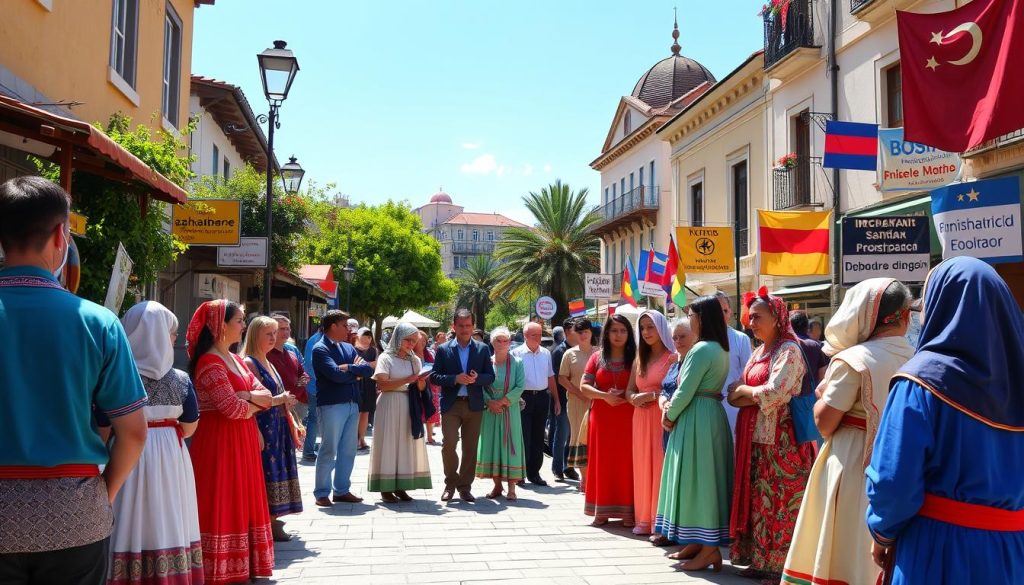
Bosnia and Herzegovina is home to a wide range of languages, not just the three official ones. The country values minority language rights. It does this through a complex and inclusive approach to cultural representation.
Immigrant communities have greatly enriched the country’s language scene. Let’s look at some of the key minority languages:
- Bulgarian: 4,100 speakers
- Italian: 3,600 speakers
- Ukrainian: 1,800 speakers
- Turkish: 1,200 speakers
- German: Small but notable community
Minority language rights in Bosnia and Herzegovina are well-protected by law. These laws help immigrant communities keep their language alive while they join the wider community.
“Language is the roadmap of a culture. It tells you where its people come from and where they are going.” – Rita Mae Brown
The government shows its support for language diversity in education and public services. Schools and public places are now more open to celebrating different languages.
Immigrant language communities are vital to Bosnia and Herzegovina’s cultural mix. They add new views, traditions, and ways of speaking. This makes the country’s culture even more rich and diverse.
Language Standardization and Policy
Language standardization in Bosnia and Herzegovina is a complex process. It aims to preserve and develop the country’s languages. This is crucial for keeping cultural identity and ensuring everyone can communicate well.
The government has worked hard to set standards for Bosnian, Serbian, and Croatian languages. They focus on making rules for spelling, grammar, and education. This helps respect the differences between these similar languages.
Government Language Initiatives
Key government strategies for language standardization include:
- Developing comprehensive linguistic guidelines
- Supporting research into language evolution
- Protecting linguistic diversity
- Promoting language education across different ethnic communities
Educational Language Standards
Language education in Bosnia and Herzegovina is vital for keeping languages diverse. The schools follow standardized policies. This ensures:
- Consistent curriculum development
- Teacher training in multilingual contexts
- Preservation of linguistic heritage
- Promotion of mutual understanding
“Language is the roadmap of a culture. It tells you where its people come from and where they are going.” – Rita Mae Brown
Understanding these efforts shows how complex Bosnia and Herzegovina’s language scene is. Language is not just for talking. It connects different cultures together.
| Language Policy Aspect | Key Characteristics |
|---|---|
| Official Languages | Bosnian, Serbian, Croatian |
| Educational Implementation | Multilingual curriculum |
| Standardization Focus | Orthography, Grammar, Vocabulary |
Impact of Historical Events on Language Development
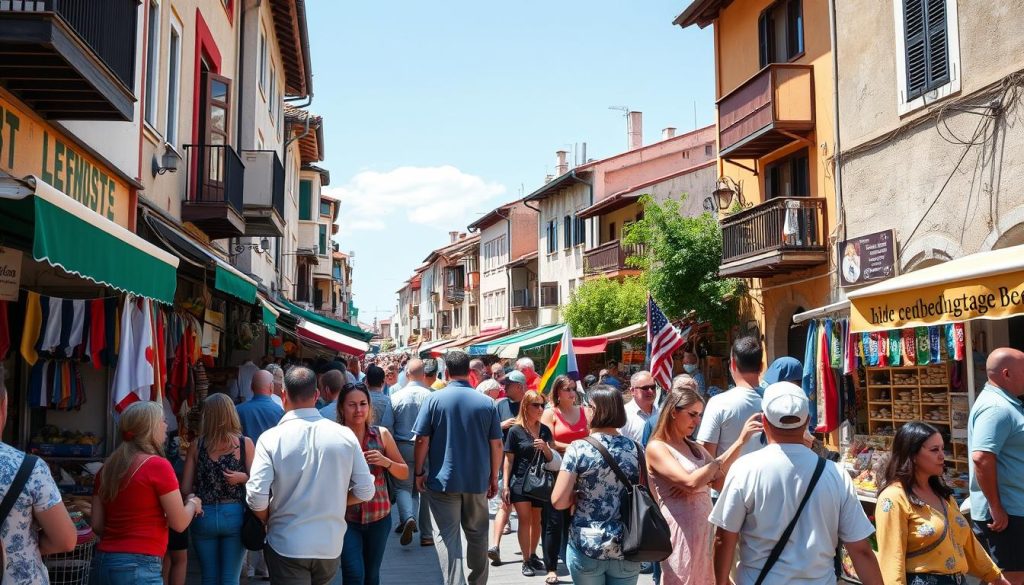
The language of Bosnia and Herzegovina has changed a lot over the years. This change came from different rulers and big events in history.
The area’s mix of languages came from many stages:
- Ottoman Empire rule (1463-1878) introduced significant linguistic influences
- Austro-Hungarian administration brought substantial language transformations
- Yugoslav period standardized language policies
- Bosnian War dramatically reshaped linguistic identities
“Languages are living records of historical experiences” – Language Scholars
When the Ottomans were in charge, Turkish words added a lot to local languages. The Austro-Hungarians then brought in German and official terms, making the mix even more diverse.
| Historical Period | Language Impact | Primary Linguistic Changes |
|---|---|---|
| Ottoman Rule | Turkish Influence | Vocabulary Expansion |
| Austro-Hungarian Era | European Administrative Language | Standardization Efforts |
| Yugoslav Period | Serbo-Croatian Dominance | Unified Language Policies |
| Post-War Period | National Language Assertion | Distinct Language Identities |
The Bosnian War (1992-1995) really changed how languages were seen. Each group wanted their language to show their culture. This made Bosnian, Serbian, and Croatian languages stand out more.
Learning about these changes helps us see how rich and complex Bosnia and Herzegovina’s language world is.
Modern Language Challenges and Solutions
In today’s world, Bosnia and Herzegovina faces special challenges with language in digital spaces. The country needs new ways to connect online while keeping its cultural roots alive.
Digital Communication Complexities
Digital areas bring big challenges for Bosnia and Herzegovina’s official languages. Local tech groups and developers must find smart ways to honor the differences between Bosnian, Serbian, and Croatian.
- Developing multilingual software interfaces
- Creating inclusive digital content platforms
- Implementing advanced translation technologies
Media and Publishing Innovations
Media groups are finding new ways to deal with language needs. Journalists and publishers make content that works for everyone, no matter their background.
“Language is not just communication—it’s cultural preservation in the digital era.”
International Relations and Language Diplomacy
Showing Bosnia and Herzegovina’s face to the world needs clever language plans. Diplomats must handle language differences while showing a strong national spirit.
By using new tech and understanding cultures better, Bosnia and Herzegovina turns language hurdles into chances for connection and teamwork.
Conclusion
Your journey through Bosnia and Herzegovina’s language world shows a complex and lively scene. The official languages, Bosnian, Serbian, and Croatian, highlight the country’s rich culture. About 1.5 million people speak Bosnian as their first language.
This language diversity is more than just talking. It’s a deep cultural heritage that ties communities together. It connects people not just in Bosnia and Herzegovina but worldwide.
Bosnian language stories reach far beyond the country’s borders. Communities in places like St. Louis and Stockholm have made Bosnian their own. This has created a global network of cultural preservation.
The diaspora from historical events has made Bosnian a symbol of strength and connection. People in the U.S., Germany, Austria, and Australia keep their Bosnian roots alive.
Learning about Bosnia and Herzegovina’s language diversity offers a peek into its complex society. The mix of Bosnian, Serbian, and Croatian shows how language can unite different cultures. Exploring this landscape shows us how language is more than just talking. It’s a living history of the country’s past, present, and future.
Looking ahead, keeping and celebrating language diversity is key for Bosnia and Herzegovina. Each language has its own story, connects families, and shows the country’s rich cultural mix. By understanding and valuing these languages, we can respect and appreciate Bosnia and Herzegovina’s unique cultural heritage.
The above is subject to change.
Check back often to TRAVEL.COM for the latest travel tips and deals.
Here are some Tours & Sightseeing suggestions that might pique your interests!
